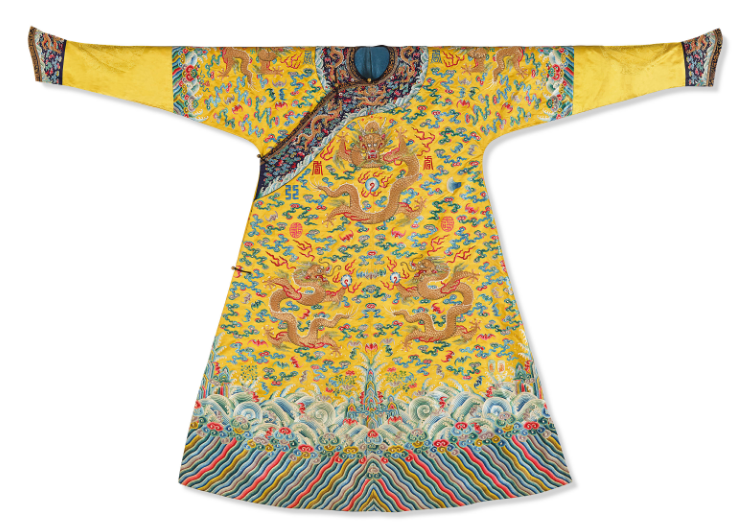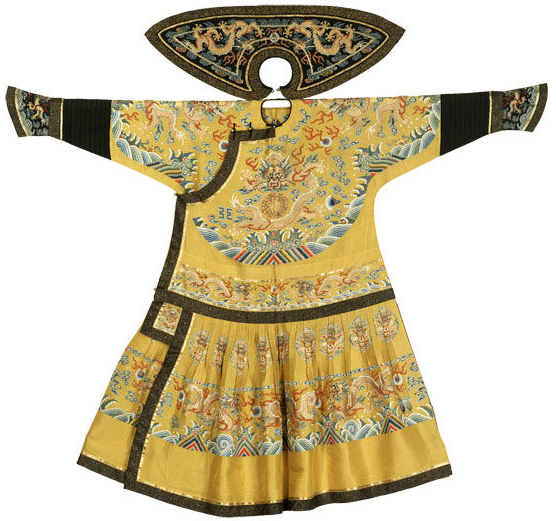Historical Significance of the Yellow Robe
Symbolism in Imperial China
In Imperial China, the yellow robe stood as a powerful symbol of supreme authority and divine rule. Emperors exclusively wore this color, reflecting their unique status as the ‘Son of Heaven’. The yellow color, associated with the center of the universe in Chinese cosmology, underscored the emperor’s central role in ruling and maintaining harmony in the empire.
Association with Chinese Emperors and Royalty
For Chinese emperors and royalty, the yellow robe was more than a garment; it was a manifestation of their absolute power and divine connection. During significant events like coronations or important ceremonies, emperors adorned these robes to visually assert their dominance and sacred role. This association created an unbreakable link between the color yellow and imperial rule, ingrained deeply in Chinese culture.
The historical significance of the yellow robe in China is profound, illustrating the intricate relationship between color symbolism, political power, and cultural beliefs. Its exclusive use by emperors highlights the stringent class distinctions and the sanctity of the imperial office in historical China. For further insights into this topic, exploring resources like Chinese Imperial Dress can provide additional historical context and details.

Cultural and Religious Connotations
Role in Traditional Chinese Ceremonies
In traditional Chinese ceremonies, the yellow robe often played a central role, symbolizing purity, nobility, and auspiciousness. During imperial enthronements and weddings, it was customary for the emperor or high-ranking officials to wear these robes, signifying a connection to heavenly powers. This practice was not just a mere tradition but a crucial element in reinforcing the sacred nature of these events.
Significance in Religious and Spiritual Practices
In religious and spiritual contexts, the yellow robe bore significant meaning, especially in Buddhism and Taoism. Buddhist monks frequently wear robes of this color, reflecting renunciation and a commitment to spiritual life. In Taoism, the yellow robe symbolizes harmony with the Tao and is often worn during key rituals and ceremonies. This color thus transcends mere aesthetic value, embodying deep spiritual and philosophical principles.
The cultural and religious importance of the yellow robe in China intertwines with the fabric of its history and spirituality. As a symbol, it transcends its physical form, representing a bridge between the earthly realm and the spiritual world. For a deeper understanding of its role in specific ceremonies and religious practices, exploring cultural and religious texts on Chinese traditions can provide further insights.
Materials and Craftsmanship
Fabrics and Textiles Used
The yellow robe, a symbol of imperial and spiritual significance, primarily utilized silk, renowned for its sheen and durability. Artisans often chose the finest quality silk, ensuring the robe not only displayed brilliance but also stood as a testament to the emperor’s wealth and status. The choice of silk, often dyed with natural substances to achieve the vibrant yellow hue, was a deliberate one, reflecting the robe’s prestigious position in Chinese culture.
Artisan Techniques in Robe Making
In crafting these regal robes, artisans employed a range of intricate techniques. Embroidery, a key element, involved detailed handiwork, often depicting dragons, phoenixes, or other symbolic motifs. The art of tailoring the robe required precise measurements and skilled hand-sewing, ensuring each robe fit its wearer perfectly. This meticulous approach to robe making reflected not just the skill of the artisans but also their deep respect for the cultural and spiritual significance of the garment.
The materials and craftsmanship involved in creating the yellow robe speak volumes about its importance in Chinese history. From the selection of fabrics to the detailed embroidery, each step in the creation process was imbued with meaning and intent. For those interested in the specifics of the materials and techniques used in historical robe making, consulting textile and fashion history resources can provide a wealth of detailed information.
Design and Aesthetics
Evolution of Style and Patterns Over Centuries
Over centuries, the design of the yellow robe evolved significantly, reflecting changes in dynastic rules and cultural preferences. Initially, the robes were simpler, focusing more on the color’s symbolism. As time progressed, intricate patterns and motifs, such as dragons, clouds, and waves, began to adorn these robes, each era adding its unique touch. This evolution in style not only showcased the artistic progress but also mirrored the changing philosophies and aesthetics of different Chinese dynasties.
Iconic Features and Ornamentation
The yellow robe is distinguished by certain iconic features. The use of dragon motifs, particularly the five-clawed dragon, was a common feature, symbolizing imperial power and authority. The inclusion of other ornamental designs like pearls, sea waves, and celestial bodies further enhanced the robe’s grandeur. Such ornamentation was not just decorative; it carried deep symbolic meanings and conveyed messages about the wearer’s status and the empire’s strength.
The design and aesthetics of the yellow robe in Chinese history are a testament to the country’s rich artistic heritage. Each element, from the fabric’s color to the embroidery’s motifs, was carefully chosen to reflect the robe’s significance and the wearer’s stature. For a detailed exploration of the design elements and their symbolic meanings, delving into historical fashion resources can provide a deeper understanding of this iconic garment.
Yellow Robe in Literature and Art
Depictions in Classical Chinese Literature
Classical Chinese literature frequently features the yellow robe, often symbolizing imperial authority and divine favor. In works like Luo Guanzhong’s “Romance of the Three Kingdoms,” the robe signifies legitimacy and power, especially when worn by key characters. Poets and playwrights used the yellow robe as a metaphor, representing themes like sovereignty, virtue, and the burden of leadership.
Representation in Traditional and Modern Art
In traditional Chinese art, the yellow robe is a recurrent motif in paintings and sculptures, often used to depict historical figures and deities. Modern artists, drawing inspiration from this legacy, have reinterpreted the yellow robe in various media, blending traditional symbolism with contemporary styles. This representation in art not only showcases the robe’s aesthetic appeal but also its enduring cultural significance.
The yellow robe’s presence in literature and art highlights its deep-rooted influence in Chinese culture. Each depiction, whether in ancient text or modern canvas, carries layers of meaning, reflecting China’s rich historical and artistic heritage. For more detailed information on its representation in specific literary works and art forms, cultural and historical studies can provide in-depth insights.

Contemporary Relevance and Adaptations
Influence on Modern Chinese Fashion
In the realm of modern Chinese fashion, the legacy of the yellow robe endures, seamlessly blending with contemporary styles. Today’s designers, drawing inspiration from its historical magnificence, infuse elements of the robe into modern clothing. This harmonious blend marries tradition with innovation, creating unique fashion statements that resonate across generations. The robe’s rich symbolism and timeless elegance serve as a foundation for these modern reinterpretations, ensuring its enduring influence in the ever-evolving world of fashion.
Use in Cultural Revival and Performances
Furthermore, the yellow robe plays a crucial role in the revival of Chinese culture and heritage, particularly in performances and festivals. It frequently appears in theatrical productions, meticulously recreating historical scenes and characters, thereby bringing the rich tapestry of Chinese history to life. These performances do more than entertain; they serve as educational tools, fostering a deeper appreciation for traditional Chinese culture among contemporary audiences. The robe’s use in these contexts not only preserves its historical significance but also reinvigorates its relevance in modern society.
The ongoing relevance of the yellow robe in modern contexts underscores its timeless appeal and deep cultural roots. As a beacon of Chinese heritage, it continues to inspire, educate, and evolve, bridging the historical past with the dynamic present. To delve deeper into its contemporary adaptations and cultural impacts, consulting resources on modern Chinese fashion and culture can offer expanded perspectives and insights.